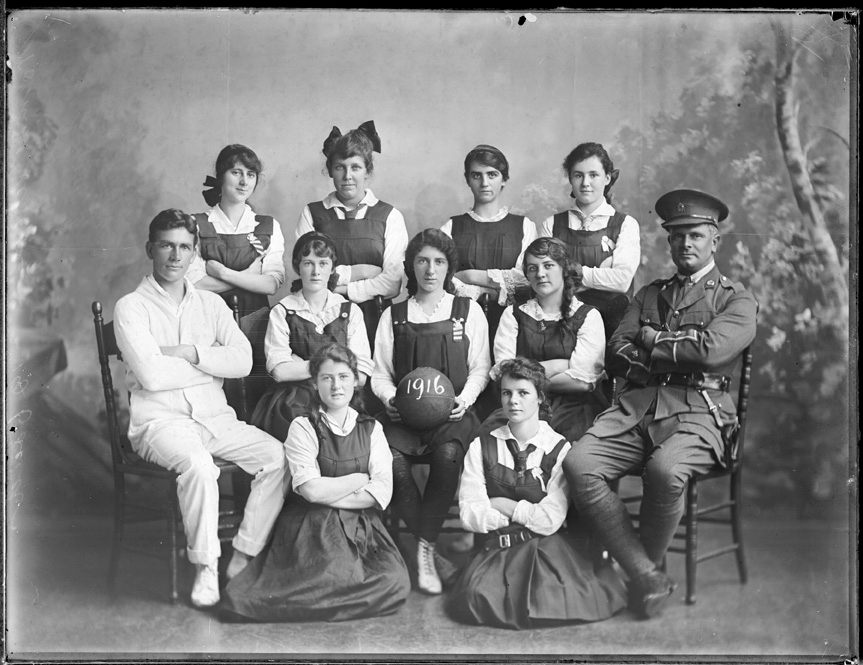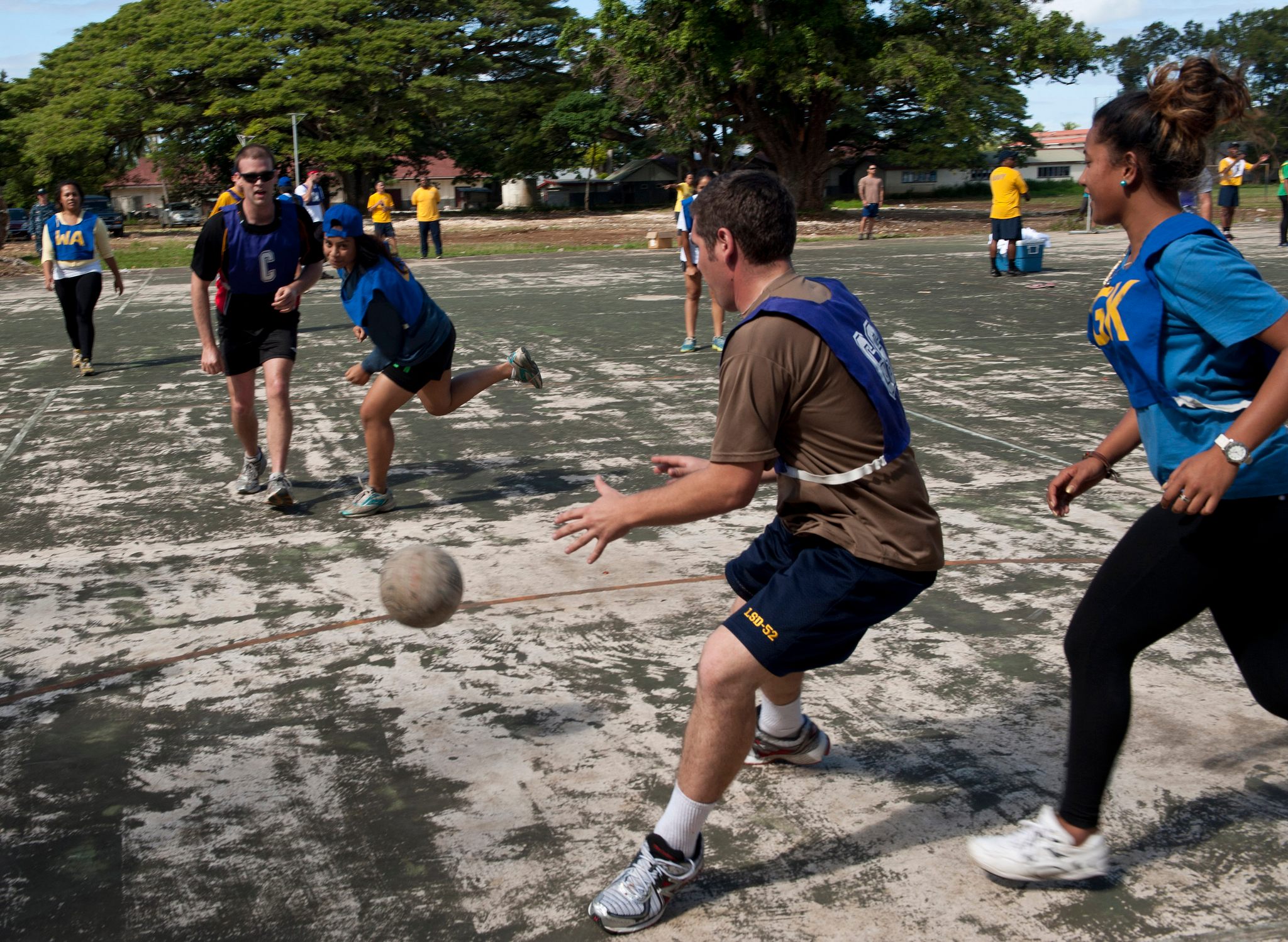Netball: The Sport America Invented, Then Lost
 What is this not-quite-basketball sport they are playing? (Photo: VanninPhotos.com/Creative Commons)
What is this not-quite-basketball sport they are playing? (Photo: VanninPhotos.com/Creative Commons)
On Friday August 7th, teams of women from 16 nations will gather in Sydney to contest the 2015 Netball World Cup.
It’s an exciting time for residents of the Commonwealth. But for Americans, it’s a big pile of “meh.” Because netball is a sport that most Americans have never heard of, let alone played. Which is ironic, considering it was invented in Massachusetts.
Netball first emerged way back in the 1890s, when it was known as women’s basketball—not the women’s basketball you’ll find at a WNBA game, but a more dainty, restricted version of the basketball that was invented for men.
The story begins in 1891, when Canadian doctor and physical education teacher James Naismith was working at the YMCA International Training College in Springfield, Massachusetts. Beset by harsh winters, Naismith was tasked with creating a sport that could be played indoors during the colder months. Making use of scant resources, Naismith came up with “basket ball,” a team game that employed 13 rules, nine players per side, a soccer ball, and two peach baskets nailed to the balcony of the YMCA gymnasium.
 Dr. James Naismith displays the core constituents of his “basket ball.” (Photo: Public domain)
Dr. James Naismith displays the core constituents of his “basket ball.” (Photo: Public domain)
In January 1892, Naismith published an introduction to this newfangled basketball business in The Triangle, the YMCA’s physical education magazine. He described it as “well suited for boys,” and a game that “may be played by gentlemen in a manly way.” Nevertheless, the article caught the attention of a woman named Senda Berenson, the gymnastics teacher at the all-female Smith College located a mere 20 miles from the Springfield YMCA.
Berenson found the game appealing, but saw a need to modify the rules for women players so they would not degenerate into unseemly masculine brutishness on the court. In an essay titled “The Significance of Basket Ball for Women,” published in 1903, Berenson wrote that “unless a game as exciting as basketball is carefully guided by such rules as will eliminate roughness, the great desire to win and the excitement of the game will make our women do sadly unwomanly things.”
The major basketball modifications that Berenson enforced at Smith College were: no snatching or batting the ball from another player; a three-second time limit for holding the ball; a limit of three dribbles; and the division of the court into thirds. Each player was restricted to one of these thirds—a safety measure put in place because, according to Berenson’s essay, “a number of girls who play without division lines have developed hypertrophy of the heart.”
 The Smith College women’s basketball team of 1902. (Photo: Public domain)
The Smith College women’s basketball team of 1902. (Photo: Public domain)
Beyond preventing women’s hearts from exploding all over the gym, the division of the court had another effect: it guarded against the emergence of dominant “star player” individuals, and made it so that goals could only be scored when all team members, restrained to their sections, cooperated to advance the ball down their part of the court.
Berenson was not the only American woman of the era who dedicated herself to turning the boisterous new game of basketball into something more restrained and ladylike. In New Orleans in 1895, Newcomb College physical education teacher Clara Baer introduced a modified version of the game with the dainty name of “basquette.” This six-per-side variant had seven court zones, no dribbling or guarding, and, in the words of Tracy Taylor in “Gendering Sport: The Development of Netball In Australia,” a set of rules ”that ensured players’ posture remained graceful.”
Another significant contributor to the early lady-fication of basketball was Martina Bergman-Österberg, a Swedish phys ed teacher who established her own women’s physical training school in London. After encountering basketball on a visit to the United States, Bergman-Österberg brought the game to her students at Hampstead Physical Training College and Gymnasium.
 A Normal School netball team in New Zealand, 1916. (Photo: Sir George Grey Special Collections, Auckland Libraries, 31-WP8110)
A Normal School netball team in New Zealand, 1916. (Photo: Sir George Grey Special Collections, Auckland Libraries, 31-WP8110)
Taylor writes that Bergman-Österberg, a robust gymnastics enthusiast and suffragette, “promoted sport as training for motherhood and for the delivery of healthy children.” In this context, women’s basketball was ideal. Not only was it played “in a manner that retained femininity and decorum,” says Taylor, but, because it restricted the players to their third of the court and involved no body contact, it was “not perceived as a threat to a woman’s reproductive function.”
It was in England that women’s basketball became “netball,” via a new name and a set of codified rules released by the phys-ed-focused Ling Association in 1901. (Confusingly, however, netball was still referred to as “women’s basketball” outside Britain until around 1970.) From England, the sport spread to far-flung parts of the British Empire—for a handy glimpse into the extent of British colonization, just look at the list of countries that play netball. From St. Lucia to South Africa to Singapore to Samoa, the geographic reach of the sport is astounding.
For may decades, the game was played with local variations—Australia fielded seven players per side, for instance, while New Zealand fielded nine. Countries played by “varied sets of rules up until the 1960s,” writes Taylor. During that decade, netball acquired global standards. The current version of the sport is played seven-a-side, with each player wearing a bib denoting their position in letters—“WD” for wing defense, “GA” for goal attack, and so forth. There is no dribbling, no taking more than two steps with the ball, and players have to remain within their positions’ designated zones and stay three feet from whoever is holding the ball.
 Netballers in Tonga. (Photo: Netina Latu/Australian Sports Commission)
Netballers in Tonga. (Photo: Netina Latu/Australian Sports Commission)
As netball flourished in the Commonwealth, its Massachusetts prototype, women’s basketball, began to peter out in the United States. During the 1960s, right when netball was getting serious by aligning to international standards and having a world championship competition, American women’s basketball took its last gasping breaths, died, and, with a boost from the introduction of Title IX in 1972, was reborn with reverted rules that aligned with men’s basketball—the basketball we know today.
Netball in America was lost. But it’s not gone forever—there’s now a movement afoot to bring it back.
Raised in netball-loving Australia, Ros Day is the VP of Education at Netball America, an association that aims to show the United States the many benefits of the game it ceded to the British Empire. One of Day’s goals is to reintroduce the sport to America by bringing it into schools across the nation. In pursuing this with the help of fellow Australian expats, however, there are some unexpected challenges to overcome. “It’s quite interesting getting past our accent,” she says, “because whenever we say ‘netball,’ they hear ‘nipple.’”
Language barriers aside, Day says that once American kids get the lowdown on what netball is, they react with curiosity and enthusiasm. Part of the appeal for them is an approach to athletics that is not often seen in the States. “The concept of playing sport socially, or for fun, in the American psyche, isn’t really there,” says Day. For young people in the United States, says Day, sports are “very competitive, it’s very specialized, and it’s with the end result of the scholarship. And if you’re not that good, then you give up and you don’t play sports anymore.”
 A young Goal Defense faces up to a Goal Shooter at All Hallows School in England. (Photo: Owen Lucas/Public domain)
A young Goal Defense faces up to a Goal Shooter at All Hallows School in England. (Photo: Owen Lucas/Public domain)
Netball, by contrast, is not about creating LeBron-style stars. With its fair division of player positions allowing for differing strengths, the game is “fully inclusive,” says Day—“no one person can dominate the game, so everyone has a role to play.”
And that includes people of all genders. Despite netball’s history as a game made for women, the staff of Netball America teach it to everyone. This approach reflects changing attitudes within the netball world—in recent decades, the sport has come to incorporate men and boys, either as part of mixed teams or in all-male sides. In countries like Australia, however, where netball has long been the most popular team sport for women, the image of it as a “girl’s game” is hard to shake. Even in the 21st century, articles about men’s growing participation in the sport still come with cutesy-bordering-on-patronizing headlines like “Netball: It’s not (just) for girls!“ and “There is no skirting it, men love netball.”
 Mixed netball teams fighting it out on a court in Tonga. (Photo: U.S. Navy/Mass Communication Specialist 2nd Class Tim D. Godbee)
Mixed netball teams fighting it out on a court in Tonga. (Photo: U.S. Navy/Mass Communication Specialist 2nd Class Tim D. Godbee)
For Americans, there is no such history to contend with: netball is a “blank slate,” says Day. And she likes to teach it to Americans as though she is re-introducing them to a once-beloved, now-forgotten friend. “America can claim it as their own,” she says. It’s “the sport that they lost and are now finding again.”










Follow us on Twitter to get the latest on the world's hidden wonders.
Like us on Facebook to get the latest on the world's hidden wonders.
Follow us on Twitter Like us on Facebook